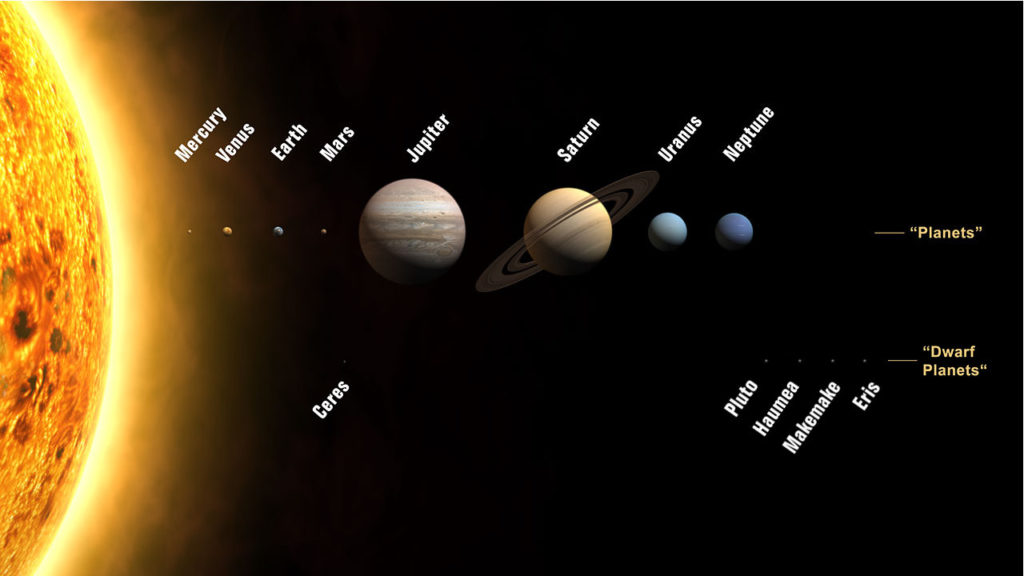Take a walk through the solar system—in your own neighborhood.
April 29, 2020
By Amy Sayle
Missing being able to travel? You can take a whirlwind vacation through our solar system—without leaving your neighborhood.
A roughly half-mile walk can take you from the Sun to Pluto, if you scale down the distances enough. In this model, 1 inch equals 100,000 miles. Every time you take 1 big step (a yard, 36 inches), you pretend to go through 3,600,000 (3.6 million) miles in space.
On this scale, a soccer ball or volleyball is the correct size to represent the Sun. The handout Solar System Walk lists other items you may already have around your home that can represent the different stops along your journey (e.g., a pinhead for Mercury, a peanut for Neptune).

Start your walk at the Sun, but don’t stay there long, or you’ll burn up. Keep your vacation moving along:
- Take 10 big steps to get to Mercury. Pack a very special spacesuit for Mercury’s daytime side, where temperatures can reach 800 degrees Fahrenheit. At night it can be more than 1000 degrees colder, so you’ll need some good long underwear.
- Take 9 more big steps to get to Venus. You think North Carolina summers are hot? Today’s forecast on Venus is about 900 degrees Fahrenheit. Not only would you be scorched, the atmosphere would poison and crush you. Best to move on quickly.
- Take 7 more big steps to get to Earth. There’s no place like home. You’re now at the only place in our solar system that we know for sure has life. Earth is a rocky planet like Mercury, Venus, and Mars. But it’s different from those planets in key ways, including the fact that most of Earth is covered by water.
- Take 13 more big steps to get to Mars. You’ll have lots of time for sightseeing on the Red Planet. The day is half an hour longer than Earth’s, and the year is almost twice as long. Be sure to check out Olympus Mons, a volcano three times as tall as Earth’s Mount Everest, and Valles Marineris, a canyon system about ten times the size of Earth’s Grand Canyon.
- Take 32 more big steps to get to Ceres. This is your first stop at a former planet (no, not that former planet). After its discovery in 1801, Ceres was declared a planet. As astronomers found more objects in that part of the solar system, Ceres was re-classified as an asteroid. In 2006, Ceres gained another classification: dwarf planet.
- Take 62 more big steps to get to Jupiter. You’re out of the zone of rocky planets, and into gas giant territory. Jupiter is mostly a giant ball of gas and liquid and doesn’t have a solid surface for your spacecraft to land. It’s just as well, because the atmosphere would poison you and crush your spacecraft. The weather is terrible, too. Jupiter has a storm, the Great Red Spot, that’s larger than Earth.
- Take 110 more big steps to get to Saturn. Your visit to Saturn would be a lot of like visiting Jupiter—no solid surface and a poisonous and crushing atmosphere. Before you leave, check out the lovely rings. From Earth they look solid, but if you get close enough on your visit you’ll see they’re billions of individual pieces made mostly of water ice.
- Take 245 more big steps to get to Uranus. At this point, you’re probably figuring out why it’s called “space.” Bring warm clothes for your visit here. The average temperature is roughly minus 350 degrees Fahrenheit.
- Take 276 more steps to get to Neptune. Pack a windbreaker. Neptunian winds are much faster than in the worst hurricanes on Earth.
- Take 240 more big steps to reach Pluto. Finally, say hello to everyone’s favorite former planet. (But say it quickly; it’s really cold out here.) In 2006, the International Astronomical Union reclassified Pluto as a dwarf planet, saying that although it’s round and orbits the Sun like the other planets, it hasn’t cleared other things out of the way of its orbital neighborhood. In other words, to be a planet you’ve got to be a gravitational bully, and Pluto is just too friendly. It orbits the Sun with lots of other friends, icy objects in the Kuiper Belt.
What about visiting the stars? Our solar system consists of only ONE star—the Sun—and everything the Sun holds in with its gravity, including the planets you visited on your walk, dwarf planets like Pluto and Ceres, moons, asteroids, and comets. The stars you see at night are part of our Milky Way galaxy, but are not part of our solar system.
You might wonder how long it’d take to reach the next star after the Sun. On our scale where 1 inch in the model equals 100,000 miles in reality, you’d need to travel nearly four thousand more miles from your neighborhood to make it to Proxima Centauri, the nearest star after the Sun. Definitely pack a lunch.
If you missed our live Morehead At Home: Skywatching session from Tuesday, April 28, be sure to check out a recorded version on YouTube. Educators Amy Sayle and Nick Eakes use this blog post to lead a virtual vacation through our solar system. Tune in Tuesdays and Thursdays at 10:00 a.m. weekly for more live virtual skywatching sessions!
